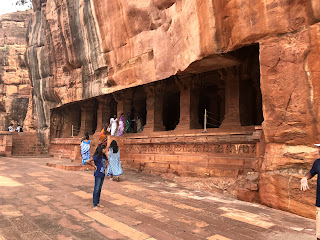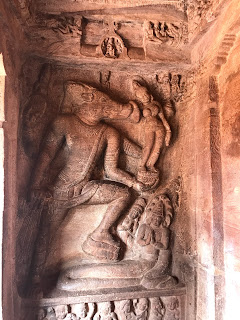The next day, we took a leap back into history and went in search of history, a further 1000 years older than the one at Hampi, moving away from the Tungabadra to the reaches of Krishna, in search of the architectural splendors of another great dynasty.
The Chalukyas, during their time of glory, had to vie for the control of their lands from North as well as from the South. They have to contend with two of the greatest kingdoms from these places and build themselves a home in the midst. The threat from North, they defeated and their tryst with the Pallavas in the south was stuff of legends and went on for a couple of hundred years.
 |
| Apsidal Durga temple |
That alone is reason enough to travel another 150 kms in hot weather to reach their center of power. However, the Chalukyas were also great builders and most of what they built stands in the banks of River Malaprabha, in the middle of nowhere in today's India, telling stories of their valor and artistic might.
The road from Kamalapur to Aihole, our first destination, is a national highway and was very good to drive on, with tiny villages and some greenery along the Tungabadra canal ways. However, the land becomes more arid and dusty as we move away from the river and looks very impoverished in outlook. The villages themselves, were looking bare with no vegetation and there are a few schools and hardly any colleges to be seen. I desperately wanted to find at least one college, just to make myself feel better, but couldn't. All I could think was, may be there is one in the towns nearby.
 |
| Varaha - The Royal Emblem of Chalukyas is seen everywhere |
Aihole, the capital of early Chalukyas, lies today on the banks of River Malaprabha in the interior of Uttara Karnataka, looking every bit the same as the thousands of villages in India, except for the cordoned off temples in the middle of it.
It is hard to believe that this village at some point in the sixth century BC, was the capital of the most powerful kingdom in this part of the world. All that remains of that glory is the group of temples in the middle of this village and the temples strewn around the hill side. There are multiple clusters of temples all around the main ASI monuments area and some of right in the middle of the huts , some are fenced off, some are left to rot. And the hillocks around have fort walls built around with the Meguti hill with the famous Jain temple atop lies on one side.
It is kind of overwhelming to be in the midst of this group of temples and awestruck is just a word here. In a way, it also shows the extent of Aihole at the height of its glory. Although touted as the capital of early Chalukyas, this looks more of an artisanal playground for the Chalukyan stone masons and engineers in the experiments they've made, in building the temples in the complex.
 |
| A familial scene in the Durga temple - Loved it |
The unusual apsidal Durga temple - which is not a Durga temple - is the quintessential symbol of Aihole and rightly so. It stands in the entrance of the complex and probably has been built at the zenith of the excellence of its period. The small temple is rich in sculptures and the vimana in the Nagara style in a raised plinth, evokes a feeling of wow immediately. The hall in the front, resembling the grand Chaityas of Buddhist viharas and the sculptures around along with sculptured pillars complete an architectural wonder which is to be seen in a life time.
 There are multiple temples in this area, mostly looking like architectural experiments in that each has something very individualistic about it. The logs on the roof, the pillars which seems to be predecessor to the later Hoysala pillars of Belur, the very distinctive fusion of Nagara and Dravida style vimanas etc are something to be seen. The raised plinth actually brings out the beauty of the temple - which is again being taken to perfection by the Hoysalas in Belur .
There are multiple temples in this area, mostly looking like architectural experiments in that each has something very individualistic about it. The logs on the roof, the pillars which seems to be predecessor to the later Hoysala pillars of Belur, the very distinctive fusion of Nagara and Dravida style vimanas etc are something to be seen. The raised plinth actually brings out the beauty of the temple - which is again being taken to perfection by the Hoysalas in Belur .
The sculptures clearly show the transition from the North Indian to a unique Chalukyan style with influences from the Buddhist, Jaina traditions of the time. It is worthwhile to note that Pulikeshin II was a Jain and the Chalukyas were of mixed religious identities as well. Hence the influences from the caves of Ellora/Ajantha can be seen clearly as well. As much as the influences on the architecture here, I could also see a lot of trading of styles between the Chalukya - Pallava temples, especially in the sculptures. It is difficult to see them without being reminded of the same in the Pallava temples or in the later Chola temples. It will be a big debate to identify who was influencing whom- but I would say there was a lot of people moving between these sites working in multiple temples bringing in their expertise and creativity.
Aihole, to do justify to all the details and temples, need a couple of days to see it in full. We had about a couple of hours. So it was in the other places we visited that day as well. So we started off to the next destination - the coronation center of the Chalukyas.























































